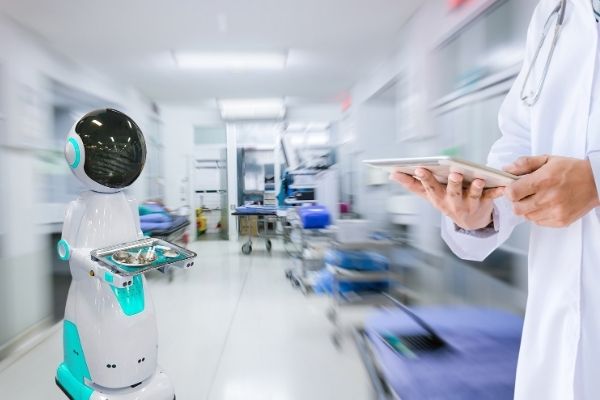Can Robot Manufacturers be the Next Fighters against the Coronavirus Pandemic
- What would be the solution to this?
- Disinfection Robots Giving Healthcare Workers Lower Risk Rates from the Pandemic
 UVD Bots, Xenex Disinfection Bot, TMiRob, & XDBOT
UVD Bots, Xenex Disinfection Bot, TMiRob, & XDBOT

What is the year 2020 associated with when thought about? The one undeniable fact, the coronavirus, a deadly virus, is on the loss all over the world. Though we are close to a vaccine, we are not there yet. You might be reading this right now when the scenario is happening or after it, but one thing which is for sure is, we do not know when everything will go back to normal or if this is the new normal after all.
When a new virus has happened to show up, there is one thing the researchers do. After months of research and data analysis on the virus, they come up with the Infection Fatality Rate [IFR]. The Infection fatality rate is to calculate how deadly new disease is. It is the proportion of the infected people who die as a result of the infection. And inclusive of those who do not get tested or show any symptoms.
It, in turn, determines how bad infection can be or how the people must retaliate to it. The coronavirus did something similar for everyone. It took away what humans need the most, socializing. Humans are social beings, and depriving them of that very primary need is what the coronavirus did.
The outbreak of the virus led to social distancing, lack of social gatherings, and much more. The worst part of the virus was, it also can infect the health system workers such as doctors, nurses, laborers, and more. Everyone in contact with the infected patient has a high chance of getting infected too.
Here is the finding of how many of them, were infected. Among 99,795 front-line healthcare-care givers and workers, 5545 were recorded positive for the coronavirus. Compared to the general community and front-line healthcare workers at a highly increased risk rate.
What would be the solution to this?
We know healthcare workers are now the brave fighters protecting the population from the increased spread of the virus, but if we could help them from it, how good would it be? It is exactly what everyone was thinking, and simultaneously the disinfectant bots came out.
The brief elaboration of how these bots are helping the healthcare industry and the healthcare workers would not be enough to understand how these robot manufacturers are about to change the way of the pandemic situation.
We put down doctors, nurses, healthcare workers on the list of 'fighters against coronavirus,' Now it is big-time, we add robot manufacturers to that list.
Robots in the healthcare industry are not new to courses, but the motive and purpose are. Robots initially in the healthcare industry were manufactured for assisted care.
Disinfection Robots Giving Healthcare Workers Lower Risk Rates from the Pandemic
 UVD Bots:
UVD Bots:
UVD Robots produced and launched by Blue Ocean Robotics, a company that is striving to give the best of the best robots for the healthcare industry. UVD bots can navigate through hospitals and large healthcare facilities and disinfect the entire place in a fraction of minutes.
This robot is deployed using a computer. It scans the environment using lidars and constructs a digital map. The operator of the bot can annotate the map with indications for disinfection.
 Xenex Disinfection Bot:
Xenex Disinfection Bot:
This robot, created by San-Antonio-based Xenex Disinfection Services LLC, produced a full-spectrum Germ-zapping robot that can eliminate harmful bacteria, viruses, and spores that cause infections.
 TMiRob:
TMiRob:
TMiRob, a robot created by TMI Robotics, is a robot that does not require an operator and moves and functions based on pre-programs. It works based on a building location or topography and spreads disinfectants, which are said to kill 99.99% of the germs.
This robot has three disinfection modes; ultraviolet, ultra-dry, and air filtration. It has the ability to be set with any of these combinations depending on the departmental rooms to be disinfected.
 XDBOT:
XDBOT:
Disinfecting large surfaces is a huge challenge and requires a high number of workforces. But the researchers from the Nanyang Technological University of Singapore could help make it an easier task. XDBOT can operate semi-autonomously in any environment using LIDAR [Light Detection and Ranging] and high definition cameras.
 The Bottom Line:
The Bottom Line:
Just like how we see robots in the kitchen, robots in labs, we can now see robots in the hospital, technology at its pinnacle at this moment.
If not for the coronavirus being spread all around the world, this very invention this not happen. The need for constant disinfection without putting anyone's life at risk became a challenge in this situation. There are two this innovation offers to the world, healthcare workers safely, along with expertise work being done.
This innovation is not estimated to stop shortly. It is like when we read about the company Blue Ocean Robotics and their disinfection bot. There is more the company is about to release; more like indoor disinfectant robots, outdoor disinfectant robots and the third robot would be designed to reduce human-to-human contact through the scanning crowds for sick people and issuing a warning if it's real-time.
